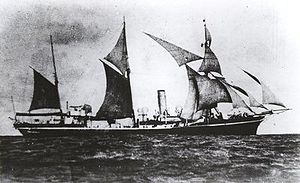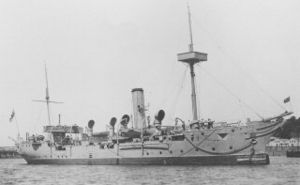Condor class sloop
| ||||||||||||||||||||||||||||||||||||||||||||
The Condor class was a six-ship class of 10-gun[3] screw steel sloops [1] built for the Royal Navy between 1898 and 1900.
Contents
Design
The Condor class was constructed of steel to a design by William White, the Royal Navy Director of Naval Construction.[3] They were powered by a three-cylinder vertical triple expansion steam engine developing 1,400 horsepower (1,000 kW) and driving twin screws.[3]
Sail Plan
The class was originally designed and built with barque-rigged sails, although some pictures show ships of the class with a barquentine rig. Condor was lost in a gale during her first commission, and the contemporary gunnery pioneer Admiral Percy Scott ascribes her sinking to the encumbrance of sails, and furthermore believed that her loss finally convinced that Admiralty to abandon sails entirely.[4] All other ships of the class had their sails removed during the first few years of the twentieth century.
Armament
The class was armed with six 4in/25pdr (1ton) Quick Firing Breech loaders and four 3-pounder Quick Firing Breech Loaders.[3]
Ships
| Name | Ship Builder | Launched | Fate |
|---|---|---|---|
| HMS Condor | Sheerness Royal Dockyard | 17 December 1898 | Foundered in a gale off Cape Flattery on 3 December 1901[2] |
| HMS Rosario | Sheerness Royal Dockyard | 17 December 1898 | Depot ship for submarines at Hong Kong in 1910. Sold there on 11 December 1921 [3] |
| HMS Mutine | William Laird & Son, Birkenhead | 1 March 1900 | Survey ship 1907, RNVR drill ship 1925, sold to Ward, Briton Ferry on 16 August 1932[3] |
| HMS Rinaldo | William Laird & Son, Birkenhead | 25 May 1900 | Sold to W Thomas, Anglesey on 21 October 1921[3] |
| HMS Shearwater | Sheerness Royal Dockyard | 10 February 1900 | Transferred to Royal Canadian Navy as submarine depot ship in 1915, sold to Western Shipping Co, Canada in May 1922 and renamed Vedas[3] |
| HMS Vestal | Sheerness Royal Dockyard | 10 February 1900 | Sold to W Thomas, Anglesey on 21 October 1921[3] |
Operational Lives
The design of the Condor class differed from the screw sloops of the 1860s only in an evolutionary sense (although constructed of steel and armed with quick-loading guns, they retained the sails and layout of the earlier vessels); by the turn of the twentieth century they were thoroughly obsolete. The overseas Stations of the Royal Navy were responsible for patrolling the maritime British Empire, and these ships were intended for that role. The rapidity with which they were converted to depot ships, training ships or survey ships gives testament to their out-moded design. According to Hansard, it was stated by the Secretary to the Admiralty about the almost identical Cadmus class in Parliament on 6 March 1905 that
| “ | they were never designed for fighting purposes but for subsidiary work in peace or war, for which they are still available, and in which they are at the present moment engaged. | ” |
HMS Condor
During her short career, Condor served on the Pacific Station. On 3 December 1901 while on passage from Esquimalt to Hawaii she foundered in a gale off Vancouver Island (position approximately 48°15′N 125°40′W / 48.25°N 125.667°W). Her last contact was with the light station on Cape Flattery. All hands (130 ship's company and 10 supernumeries) were lost.[6] The tragedy occurred during her first commission and less than three years after her launch.[2] In May 1949 the trawler Blanco hauled up wreckage from a depth of 250 ft (76 m) The wreckage included a ship's binnacle matching that supplied to Condor.[7]
HMS Rosario
Rosario relieved HMS Rattler on the China Station in June 1900, and re-commmissioned at Hong Kong on 5 November 1913, becoming a depot ship for submarines.[8] She was sold at Hong Kong in December 1921.
HMS Mutine
While being delivered from Birkenhead to Portsmouth an accident in Mutine's boiler rooms caused some loss of life and gave her a name as an unlucky ship before her career even began.[9] She served on the China Station and became a survey ship, surviving until 1932 as an Royal Naval Volunteer Reserve drill ship, the last of her class to be sold.
HMS Rinaldo
Rinaldo served in South-East Asia, including taking medical assistance to Brunei in August 1904 during an outbreak of smallpox.[10] By 1914 she was tender and training ship to HMS Vivid, Devonport RNR.[11] She was sold for breaking in October 1921.
HMS Shearwater
Shearwater served on the Pacific Station. She recommissioned on 27 November 1912 at Esquimalt.[12] She was transferred to the Royal Canadian Navy as a submarine depot ship in 1915, sold to Western Shipping Co, Canada in May 1922 and renamed Vedas[3]
HMS Vestal
Vestal served on the China Station, later becoming training ship and tender to HMS Excellent, Portsmouth.[13] She was sold for breaking on the same day as Rinaldo.
See also
 Media related to Condor class sloop at Wikimedia Commons
Media related to Condor class sloop at Wikimedia Commons
References
- ↑ 1.0 1.1 1.2 "Condor class at battleships-cruisers.co.uk". http://www.battleships-cruisers.co.uk/condor_class1.htm. Retrieved 2008-08-30.
- ↑ 2.0 2.1 2.2 "HMS Condor at Naval Database website". http://www.pbenyon.plus.com/18-1900/C/01071.html. Retrieved 2008-09-06.
- ↑ 3.00 3.01 3.02 3.03 3.04 3.05 3.06 3.07 3.08 3.09 3.10 3.11 3.12 3.13 Winfield, Rif; Lyon, David (2003). The Sail and Steam Navy List, 1815-1889. Chatham Publishing. ISBN 978-1861760326.
- ↑ Fifty Years in the Royal Navy, Admiral Sir Percy Scott, Bt., John Murray, London, 1919, p.37
- ↑ "Hansard, 6 March 1905 vol 142 cc402-3, Questions in the House". http://hansard.millbanksystems.com/commons/1905/mar/06/hms-clio-and-cadmus. Retrieved 2008-09-07.
- ↑ BBC Radio 4, Making Waves, 06 May 2003 (RealPlayer required)
- ↑ "NOAA Olympic Coast National Marine Sanctuary website". http://olympiccoast.noaa.gov/living/history_and_culture/shipwrecks/condor.html. Retrieved 2008-09-06.
- ↑ "HMS Rosario at Naval Database website". http://www.pbenyon.plus.com/18-1900/R/03988.html. Retrieved 2008-09-06.
- ↑ "Condor class (additional page) at battleships-cruisers.co.uk". http://www.battleships-cruisers.co.uk/condor_class.htm. Retrieved 2008-09-06.
- ↑ Colonial Office Correspondence Relating To Brunei 'Destroyed Under Statute' 1906–1934, by A V M Horton, IJAPS Vol. 1 2005
- ↑ "HMS Rinaldo at Naval Database website". http://www.pbenyon.plus.com/18-1900/R/03947.html. Retrieved 2008-09-06.
- ↑ "HMS Shearwater at Naval Database website". http://www.pbenyon.plus.com/18-1900/S/04243.html. Retrieved 2008-09-06.
- ↑ "HMS Vestal at Naval Database website". http://www.pbenyon.plus.com/18-1900/U/05007.html. Retrieved 2008-09-06.
| ||||||||



